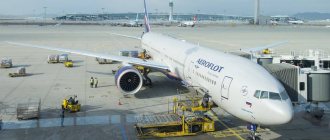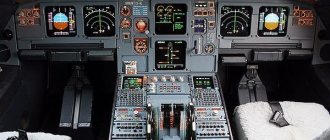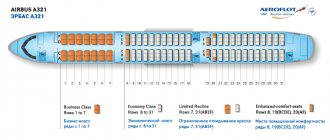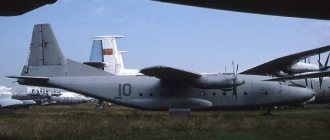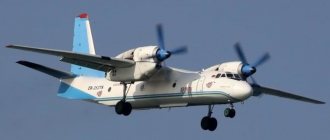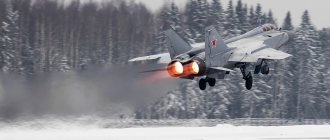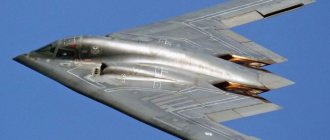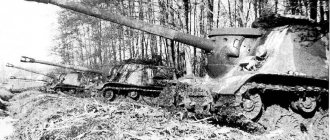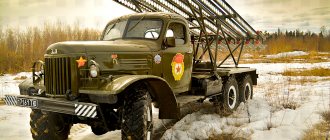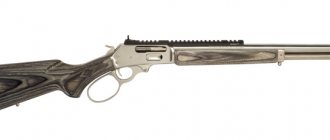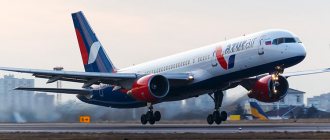Overview of the interior and layout of the best seats
The passenger cabin of the Airbus A340 has a three-class layout and can accommodate from 261 (A340-200 modification) to 419 passengers (A340-600 modification).
The first class cabin of the Airbus A340 can be represented by a number of seats from 6 to 8, located in one row (as shown in the diagram, this is row 1), or in two rows, which, if necessary, can be expanded and turned into comfortable beds. On some aircraft, these seats are equipped as cozy closed compartments with doors. First class passengers are provided with an exquisite menu, internet, USB charging for mobile devices, convenient screens and a multimedia entertainment system - in short, a complete package to make the flight as comfortable as possible.
However, it should be noted that first class seats located in the first row may have a number of inconveniences. The main inconvenience is that these places are located near the on-board kitchens and toilets, which ensures a steady flow of passengers and service personnel during the day and night. The bustle around these places, slamming doors and lights at night can seriously interfere with a relaxed and peaceful holiday. Please keep this in mind when purchasing first class tickets on an Airbus A340.
Next to the first class cabin are business class seats. According to the diagram, these seats are located from rows 2 to 5. The business class of the Airbus A340 is represented by comfortable and soft seats, equipped with comfortable armrests and screens installed on the backs of the seats located opposite. The menu here, of course, is not the same as for first class, but, nevertheless, tasty and restaurant-quality. The space between the seats in business class is large enough to stretch your legs, but the seats can also be reclined and turned into beds for complete relaxation. In addition, business class seats come with a set of socks and blindfolds so that nothing can disturb passengers' restful sleep.
The most unfortunate seats for business class are those located in the back row (row 5 according to the diagram), that is, directly adjacent to the toilets and galley. These places are also associated with a constant flow of people and bustle, which interferes with proper rest.
Behind business class there is a lounge for economy class passengers. The aircraft's economy class seats are located from rows 10 to 46. This class is characterized by soft, comfortable seats, the distance between which is slightly more than 80 cm, which usually does not cause inconvenience even for tall passengers, three rows of seats in the “2-4-2” option and two fairly wide aisles in the middle of the cabin. Economy class seats on the Airbus A340 aircraft are equipped with an audio and video entertainment system and convenient screens built into the backrests of the opposite seats.
The most successful and convenient seats for economy class on an Airbus are those marked with the letters A, B, K and L, located in row 31 according to the diagram. This is explained by the fact that these places do not have other places in front of them, which significantly increases legroom for them, and the toilets are not located close, which makes these places somewhat “away” from the general bustle and flow of passengers.
Economy class seats located in rows 10 and 30 are not a very good choice. The close proximity of toilets and utility rooms creates a lot of inconvenience for passengers located here. And finally, the least successful seats for economy class are rows 27 and 45.
Design
The A340 is a monoplane with a cantilever swept wing. The large aspect ratio and the presence of end aerodynamic surfaces provide high aerodynamic efficiency (10 units) and reduce induced drag. The caisson wing has a large relative thickness, which increases the internal volumes for fuel. Improved load-bearing properties made it possible to reduce the area, total weight of the structure and, as a result, fuel consumption. The wing is made of high-strength aluminum alloys and composites. Monolithic panels were also widely used, which simplified assembly and reduced production costs. This also reduced the weight of the structure and reduced the number of potential areas of seal failure. The elimination of overlapping joints and a small number of holes for bolts reduced the number of places where cracks could arise.
Each console has flaps and, interestingly, seven sections of slats, occupying almost the entire length of the leading edge. Both flaps and slats are controlled automatically using the EMDS. The outer sections of the spoilers work as aileron spoilers, which increases the efficiency of lateral control and improves the cruising aerodynamics of the wing. The fuselage is of semi-monocoque design, round in cross section. Composites were widely used in the tail structure, which significantly reduced weight. The aircraft has a three-post retractable landing gear with articulated suspension of wheeled bogies. The nose strut has dual steerable wheels. Each main rack is equipped with two two-wheeled trolleys with tandem wheels. The braking system is automatic.
The A340 navigation systems allow the crew to fly in automatic mode. A special device for determining the center of gravity gives the corresponding signal to set the elevator trim. The aircraft's cabin is identical to that of other Airbus aircraft. The main difference is the larger dimensions, devices for two more motors, and a slightly modified ceiling panel. The instrument panel has six multifunctional displays: the outer screens act as “flight displays” (primary information), and the middle ones act as navigation displays. Both middle screens are also used to transmit information about the parameters of systems and engines in an emergency. There is also a backup circuit that provides the pilot with the ability to land the aircraft in case of failure. New generation crew seats - with an electric control system on three axes and with a reclining backrest. The position of the pedals and the height of the armrests are adjustable. There are side control handles on the left and right.
The history of the Airbus A340
Development of the Airbus A340 began in 1987. From the very beginning, the Airbus consortium positioned the future aircraft as a “brother” to the A320. Also, the new aircraft, named A340, was supposed to become a competitor to the Boeing 747 as a long-haul passenger airliner. The first flight of the A340 (Airbus A340-300) was carried out on November 25, 1991, and already in 1993 the commercial use of the aircraft began.
The modification of the Airbus A340-500, presented as the longest-range aircraft in the world, was certified in December 2002, and its operation began in 2003. At the same time, the Airbus A340-600 aircraft was being developed, which had the largest passenger capacity among the A340 family. The first flight of the Airbus A340-600 took place in April 2001, and in the summer of 2002 its commercial use began.
However, due to the lower efficiency of the aircraft compared to Boeing aircraft, its demand began to seriously decline, especially with the rise in price of aviation fuel. As a result of a number of attempts to reduce the fuel consumption of the A340 and increase its popularity, Airbus was forced to announce the cessation of production of the Airbus in the fall of 2011.
History[ | ]
Schematic representation of the A340 family
The A340 aircraft project (originally TA11 - TA - twin aisle - “double aisle”) was first presented to the public in 1981 in the November edition of Air International magazine. The issue also indicated the expected characteristics of the future aircraft. In September 1982, the consortium announced that the new aircraft would have a common airframe design. The development program was launched in June 1987. The goal is to create a long-haul “brother” for the short-haul A320 and medium-haul A300. At that time, twin-engine Airbus aircraft were inferior to the four-engine Boeing 747 according to ETOPS standards: twin-engine aircraft must always be at a certain distance from an alternate airfield during a flight in case one of the engines fails. In this regard, the A340 was a fundamentally new aircraft in the Airbus family, created specifically for intercontinental flights.
In June 1995, during the next international aerospace exhibition in Paris, the Airbus consortium announced plans to develop a new modification of the A340-200 aircraft, capable of non-stop flights on routes over 14,000 km. During the development of the A340 aircraft, the consortium first designed a variant with a flight range of 12,400 km, which was identical in size to the A330-300. But an analysis of the development prospects of the global market showed that increased demand is expected for wide-body aircraft with a flight range of up to 14,000 km. In this regard, Airbus began creating a modification of the A340-200, which featured a fuselage length reduced by 4.26 m. The passenger capacity of the aircraft was reduced, but the flight range was increased to 13,800 km.
Flight testing of the prototype A340-300 began on October 25, 1991, and the A340-200 in April 1992. Certification of both variants according to European JAA standards was completed at the end of December 1992, and in May 1993 they received FAA certification. At the end of February 1993, Air France received the first A340-300 aircraft. At the beginning of February 1993, the first A340-200 joined the fleet of the German airline Lufthansa.
On June 16-18, 1993, the A340-200 aircraft, named World Ranger, performed a round-the-world flight on the route Paris - Auckland (New Zealand) - Paris with one stop in Auckland. This vehicle, designated A340-8000 (A340-200HGW), differed from the basic version by the presence of three additional fuel tanks in the rear cargo compartment. The entire flight lasted 48 hours 22 minutes. On the 19,100 km Paris-Auckland route, the flight time was 21 hours 32 minutes, which was recognized as a new record for this route. But this record was broken in the spring of 1997 by the American Boeing 777-200IGW.
When fuel prices went up, the Boeing 777, as a more fuel-efficient aircraft, began to outperform Airbus in terms of the number of orders. The number of orders for the A340 has been steadily declining. In 2005, Airbus received an order for only 15 aircraft.
Initially, it was planned to install IAE (International Aero Engines) engines on the aircraft, but after the sudden cessation of IAE development on the A340, it was decided to install the CFM56-5C4 engine. The A340 first took to the air in October 1991, and at the same time engineers discovered the first serious flaw of the aircraft: under the weight of four engines, the A340 wing planes, taken from the twin-engine A330, constantly experienced excessive vibration and sagged during flight. To eliminate this defect, the wing was modified, and the wing plastron in the area where the pylons were attached was significantly strengthened. In 1993, the aircraft entered service, the first customers were Lufthansa and Air France.
In January 2006, Airbus announced the creation of an improved version - the A340E (Enhanced). Due to the colossal increase in fuel prices in 2004-2005, sales of the A340 decreased significantly. The Boeing 777 remained the most popular long-haul aircraft, but Airbus argued that the new aircraft would be significantly more economical than the first versions of the A340.
In November 2011, Airbus announced the cessation of production of the long-haul A340 airliner. “We haven’t sold a single A340 for two years,” said corporate chief financial officer Hans Peter Ring. He added that the aircraft could not compete with the Boeing 777.[4]
Airbus A340 modifications
The Airbus A340 has 4 modifications:
- Airbus A340-200 is one of the first modifications of the Airbus and has a passenger capacity of 261 people with a three-class passenger cabin layout. It is the shortest variant of the A340. Has 4 CFM56-5C4/P engines. Due to the small number of passengers that the aircraft was capable of carrying, its large wingspan and relatively high operating costs led to low demand for the Airbus A340-200, which is why it is currently out of production.
- The Airbus A340-300 is another of the very first modifications of the aircraft, which began operation in 1993. The passenger capacity of the Airbus A340-300 aircraft is 295 people. The aircraft is equipped with 4 CFM56-5C engines. Two additional versions of the Airbus A340-300 airliner were also developed: A340-313X (increased take-off weight) and A340-313E (installed CFM56-5C4s engines, thereby increasing take-off weight). Currently, the Airbus A340-300, like all aircraft of the A340 family, is not in production.
- The Airbus A340-500 is a modification of the aircraft capable of carrying up to 313 passengers and capable of flying over a distance of up to 16 thousand kilometers. The A340-500 features a slightly larger fuselage, increased fuel capacity and higher cruising speed.
- Airbus A340-600 is a modification of the Airbus A340-600, which has more powerful engines (Trent 556 from Rolls-Royce). Capable of carrying up to 419 passengers with a two-class layout or up to 380 with a three-class layout. It ranks second in the world in terms of length among passenger aircraft. The A340-600 also has a version of the A340-600HGW with increased take-off weight and flight range and more powerful engines (Rolls-Royce Trent 560).
Aircraft losses
Over the years of operation, 5 A340 type aircraft were lost, but not a single person was killed[6].
| date | Board number | Disaster site | Victims | Short description |
| 20.01.1994 | F-GNIA | Paris | 0/0 | While being towed to the terminal, a fire started on board. |
| 24.07.2001 | 4R-ADD | Colombo | 0/0 | Destroyed in a Tamil Tiger attack on the airport |
| 02.08.2005 | F-GLZQ | Toronto | 0/309 | When landing in unfavorable weather conditions, it rolled off the runway and burned out. Crew error (reverse was not turned on in time). Several dozen wounded of varying severity. |
| 09.11.2007 | EC-JOH | Quito | 0/349 | Several tires exploded during landing. Rolled off the runway. |
| 15.11.2007 | F-WWCJ | Toulouse | 0/9 | The crew was revving the engines without putting the plane on the stops. |
Brief overview of the aircraft and characteristics
The Airbus A340 is a wide-body monoplane. The wing is swept, cantilever. The fuselage of the Airbus has a semi-monocoque design. The cross section of the Airbus A340 fuselage is circular. The aircraft's power plant consists of 4 engines.
Airbus A340 characteristics:
| A340-200 | A340-300 | A340-500 | A340-600 | |
| Wingspan, m | 60,3 | 60,3 | 63,5 | 63,5 |
| Wing sweep angle, ° | 30 | 30 | 31 | 31 |
| Length, m | 59,4 | 63,7 | 67,9 | 75,4 |
| Height, m | 16,8 | 16,9 | 17,3 | 17,2 |
| Chassis base, m | 23,2 | 25,6 | 27,6 | 32,9 |
| Cruising speed | Max 0.82 (871 km/h) | Max 0.83 (881 km/h) | ||
| Maximum speed | Max 0.86 (913 km/h) | Max 0.86 (913 km/h) | ||
| Range of flight | 15,000 km | 13,700 km | 16,670 km | 14,600 km |
| Passenger capacity (3 classes) | 261 | 295 | 313 | 380 |
| Passenger capacity (maximum) | — | 440 | 375 | 475 |
| Cargo capacity | 18 LD3 containers/6 pallets | 32 LD3 containers/11 pallets | 30 LD3 containers/10 pallets | 42 LD3 containers/14 pallets |
| Engines (4 pcs.) | CFM56-5C4/P | CFM56-5C4/P | RR Trent 500 | RR Trent 500 |
| each 151 kN | each 151 kN | each 235–249 kN | each 249 kN | |
